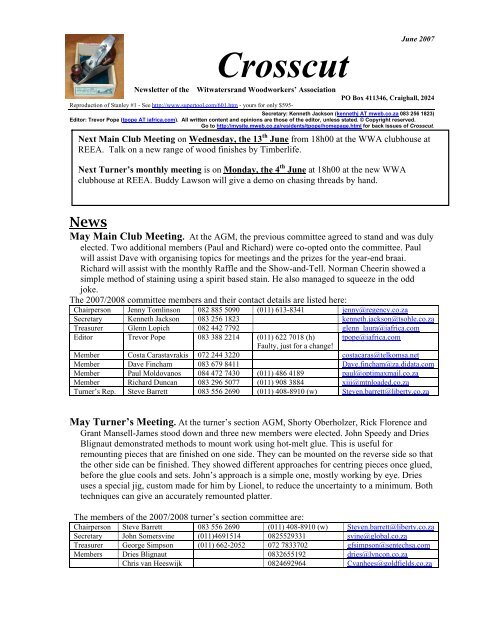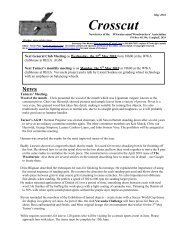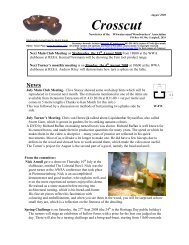June 2007 - Wits Woodworking Association
June 2007 - Wits Woodworking Association
June 2007 - Wits Woodworking Association
Create successful ePaper yourself
Turn your PDF publications into a flip-book with our unique Google optimized e-Paper software.
<strong>June</strong> <strong>2007</strong><br />
Crosscut<br />
Newsletter of the Witwatersrand Woodworkers’ <strong>Association</strong><br />
PO Box 411346, Craighall, 2024<br />
Reproduction of Stanley #1 - See http://www.supertool.com/601.htm - yours for only $595-<br />
Secretary: Kenneth Jackson (kennethj AT mweb.co.za 083 256 1823)<br />
Editor: Trevor Pope (tpope AT iafrica.com). All written content and opinions are those of the editor, unless stated. © Copyright reserved.<br />
Go to http://mysite.mweb.co.za/residents/tpope/homepage.html for back issues of Crosscut.<br />
Next Main Club Meeting on Wednesday, the 13 th <strong>June</strong> from 18h00 at the WWA clubhouse at<br />
REEA. Talk on a new range of wood finishes by Timberlife.<br />
Next Turner’s monthly meeting is on Monday, the 4 th <strong>June</strong> at 18h00 at the new WWA<br />
clubhouse at REEA. Buddy Lawson will give a demo on chasing threads by hand.<br />
News<br />
May Main Club Meeting. At the AGM, the previous committee agreed to stand and was duly<br />
elected. Two additional members (Paul and Richard) were co-opted onto the committee. Paul<br />
will assist Dave with organising topics for meetings and the prizes for the year-end braai.<br />
Richard will assist with the monthly Raffle and the Show-and-Tell. Norman Cheerin showed a<br />
simple method of staining using a spirit based stain. He also managed to squeeze in the odd<br />
joke.<br />
The <strong>2007</strong>/2008 committee members and their contact details are listed here:<br />
Chairperson Jenny Tomlinson 082 885 5090 (011) 613-8341 jenny@regency.co.za<br />
Secretary Kenneth Jackson 083 256 1823 kenneth.jackson@tsohle.co.za<br />
Treasurer Glenn Lopich 082 442 7792 glenn_laura@iafrica.com<br />
Editor Trevor Pope 083 388 2214 (011) 622 7018 (h) tpope@iafrica.com<br />
Faulty, just for a change!<br />
Member Costa Carastavrakis 072 244 3220 costacaras@telkomsa.net<br />
Member Dave Fincham 083 679 8411 Dave.fincham@za.didata.com<br />
Member Paul Moldovanos 084 472 7430 (011) 486 4189 paul@optimaxmail.co.za<br />
Member Richard Duncan 083 296 5077 (011) 908 3884 xiii@mtnloaded.co.za<br />
Turner’s Rep. Steve Barrett 083 556 2690 (011) 408-8910 (w) Steven.barrett@liberty.co.za<br />
May Turner’s Meeting. At the turner’s section AGM, Shorty Oberholzer, Rick Florence and<br />
Grant Mansell-James stood down and three new members were elected. John Speedy and Dries<br />
Blignaut demonstrated methods to mount work using hot-melt glue. This is useful for<br />
remounting pieces that are finished on one side. They can be mounted on the reverse side so that<br />
the other side can be finished. They showed different approaches for centring pieces once glued,<br />
before the glue cools and sets. John’s approach is a simple one, mostly working by eye. Dries<br />
uses a special jig, custom made for him by Lionel, to reduce the uncertainty to a minimum. Both<br />
techniques can give an accurately remounted platter.<br />
The members of the <strong>2007</strong>/2008 turner’s section committee are:<br />
Chairperson Steve Barrett 083 556 2690 (011) 408-8910 (w) Steven.barrett@liberty.co.za<br />
Secretary John Somersvine (011)4691514 0825529331 svine@global.co.za<br />
Treasurer George Simpson (011) 662-2052 072 7833702 gfsimpson@sentechsa.com<br />
Members Dries Blignaut 0832655192 dries@lyncon.co.za<br />
Chris van Heeswijk 0824692964 Cvanhees@goldfields.co.za
<strong>June</strong> <strong>2007</strong> - Page 2<br />
From the committee:<br />
Clubhouse Floor. The levelling and painting of the floor was completed just in time for the first<br />
meetings of May. A durable grey epoxy coating was applied and this should stand up to many<br />
years of wear and tear. Thanks to Costa for organising and supervising this work. It has made the<br />
clubhouse much more habitable.<br />
Training. Don’t forget to consult the list of courses on the notice board. Payment for courses booked<br />
will be in advance, to ensure attendance.<br />
Toymakers. The toymakers meet on the first and third Monday of every month, at 09h00 till 12h00 at the<br />
new clubhouse. Contact Eddie Marchio on (011) 678-8062 or renato@pixie.co.za for more information.<br />
Wednesday Workshop. The Wednesday evening workshop is on the first and third Wednesdays of the<br />
month, from 18h00 till 20h00. Contact Winston Klein on (011) 674-1513 for more information.<br />
For Sale:<br />
Router – Startel Pro 1900W, with 12 bits, micrometer depth gauge, variable speed, spindle lock and rubber grips. Brand<br />
new, not used. Asking R1000-. Contact Ivor Appleton on 011 646 3034 after hours.<br />
Dewalt planer / thicknesser model dw50. Excellent condition - fully reconditioned. R4500-00.<br />
Ryobi thicknesser model ap-10. Made in Japan. R1500-00. Contact Norman Cheerin on 082.443-7325.<br />
Approximately 3 cubic metres of timber, including Iroko, Meranti, Imbuia, etc. Sizes range from 600mm to 1200mm.<br />
Please contact Russell on 076 972 4999 or rgerlag@mf.co.za. Russell is based in the south of Johannesburg.<br />
Adjusting and Using the Stanley Number 78 Rebate Plane<br />
Trevor Pope<br />
The first section is copied from http://www.supertool.com/StanleyBG/stan10.htm - by<br />
Patrick Leach - well written and duly acknowledged.<br />
#78 Duplex fillister and rabbet plane, 8 1/2"L (8 1/4", 1936 on), 1 1/2"W, 3lbs,<br />
1885-1973.<br />
This is another popular Stanley plane, on<br />
which the company built a great fortune.<br />
Nearly every workman of the time had one of<br />
these planes in their kits. This plane was so<br />
popular and functional, that it still is made<br />
today. Any hand tool enthusiast should<br />
consider this plane, or one like it, be it a<br />
competitor's or a wooden version, as part of<br />
his arsenal.<br />
The plane has two beds for the cutter - one<br />
positioned for normal work, and the other for<br />
bull-nose work. The cutter has no cap iron,<br />
and is held in place by a thumb screw<br />
activated lever cap. Earlier models, with the<br />
common floral vines cast into the handle,<br />
required hand adjustment to set the iron, but
<strong>June</strong> <strong>2007</strong> - Page 3<br />
in 1925, a lever, which engages machined grooves in the backside of the iron, was provided to<br />
accomplish this. Around 1910, the handle has a fish scale-like pattern cast into it.<br />
There is an adjustable depth stop on the right hand side of the plane, secured in place by a thumb<br />
screw. Directly below the depth stop, is a three-pronged spur to score the grain that sits flush with<br />
the side of the plane. It can be turned up out of the way when it isn't needed. There is no spur on<br />
the left of the plane.<br />
A rod, threaded on one end, is used as the arm on which the fence is secured. The arm can be<br />
attached either to the left of the plane, for working right-handed, or to the right of the plane, for<br />
reversing the plane to work left-handed. This is a nice feature designed to handle problem grain<br />
while working. However, there is no provision for the depth stop on the left side of the plane, so<br />
you'll need to plane to a gauged line, or do it by eye, when using the plane left-handed. The<br />
threaded rod has a hole drilled through it on its end. This hole permits a nail, or something<br />
similar, to pass through it in order to tighten or loosen the rod. Many of the rods are bent right<br />
where the threads start so check this area by unscrewing the rod - you'll notice whether it's bent as<br />
you unscrew it.<br />
The fence is secured to the arm with a thumb screw. Sometimes you'll find examples where the<br />
thumb screw is replaced with a slotted round head screw. This is due either to the thumb screw<br />
being misplaced, or the original thumb screw being stripped. Also, the fence is sometimes broken;<br />
when the fence is attached to the left side of the plane, the back portion of the fence is longer than<br />
the front portion by about 3/4". Look at the fence, with the thumb screw toward you. The aperture<br />
for the arm should noticeably be to the left.<br />
This plane is often found with parts missing - most often it is the depth stop and/or fence. You can<br />
usually scrounge parts from other models, but this approach usually ends up costing you more for<br />
an assembled one than it does for buying a complete one. It's also possible to find the plane with<br />
the section of the sole ahead of the bull nose bed snapped off. Some guys ground this section off<br />
so that they could use the plane as a chisel plane or to worked stopped rabbets right to their very<br />
end, which can't be done with this portion of the sole present. Planes that were accidentally<br />
broken will have the section brazed back onto the main casting.<br />
example of this decal).<br />
The #78 pictured with its original<br />
box dates from the 1920's, with the<br />
most obvious clue being the depth<br />
adjustment lever for the cutter. It<br />
has the common decal on the<br />
handle, which Stanley applied to<br />
many of their planes and other<br />
hand tools. It can be found applied<br />
to the totes on the Bailey and Bed<br />
Rock bench planes, special purpose<br />
planes such as this one, sliding<br />
bevels, try squares, etc. The block<br />
planes and some of the other<br />
smaller planes, like the #95, used a<br />
smaller decal that's noticeably<br />
yellow (see the #220 for an<br />
This #78 also illustrates another common occurrence with Stanley - the use of early labels on<br />
boxes of later planes. The label on this plane, often called the "picture label" because of the line
<strong>June</strong> <strong>2007</strong> - Page 4<br />
drawing of the tool contained within, was in widespread use starting around 1905. When this<br />
plane was made, Stanley was in the midst of what is known as the sweetheart era, where tools<br />
have the heart logo stamped in them somewhere. Even the box labels had a tiny heart on them as<br />
part of the logo. However, Stanley was also frugal in their unwillingness to toss something that<br />
was still perfectly usable, in this case a label. So, here is a plane made during the 1920's with a<br />
label used a few decades earlier. Keep in mind that it's impossible to date accurately Stanley stuff<br />
by the boxes alone. Generally, the latest feature on the tool, in this case the label, is the more<br />
accurate clue to the plane's approximate date of manufacture.<br />
<br />
Adjustment and tuning of the #78<br />
The term rebate or rabbet plane is refers to a plane without fences or depth stops. When<br />
the plane is fitted with a fence and depth stop as shown, it is also called a fillister plane.<br />
The Stanley #78 is the most common<br />
rebate/fillister plane and as recorded<br />
above, has been produced for over a<br />
century. It is still used and is widely<br />
available second hand as a result. It<br />
has a square blade and a single spur<br />
or nicker on the right-hand side. A<br />
single rod projecting from the left side<br />
supports the fence, as you can see<br />
from the diagram. The design of the<br />
Record #778 is slightly better in this<br />
respect in that it has two rods to<br />
support the fence, which is more rigid<br />
as a result.<br />
When buying second hand, be sure to<br />
properly inspect the plane for cracks<br />
and missing parts. As mentioned<br />
above, sometimes the front toe is<br />
broken off and often the fence and<br />
depth stop are missing. Spares are still available from Stanley. Quote the plane model<br />
and the name of the part from the list below, to get the right parts.<br />
A<br />
B<br />
C<br />
D<br />
E<br />
F<br />
G<br />
H<br />
I<br />
J<br />
K<br />
L<br />
M<br />
DUPLEX RABBET PLANE<br />
Plane Body<br />
Adjusting Lever<br />
Plane Iron or Cutter<br />
Lever Cap<br />
Lever Cap Screw<br />
Fence Arm<br />
Fence<br />
Depth Gauge<br />
Depth Gauge Screw<br />
Washer<br />
V-slide for Depth Gauge<br />
Spur<br />
Screw Hole for Fence Arm<br />
The #78 can be used for making<br />
fine adjustments to tennons, but if<br />
you have one, a shoulder plane<br />
(Stanley #90, #92 or #93 or<br />
equivalent) with a finely set mouth<br />
and low blade angle may be better.<br />
To fine tune the width of a groove a<br />
Stanley #79 side rebate plane can<br />
be used after the #78 has done the<br />
heavy cutting.<br />
Continued next month.








